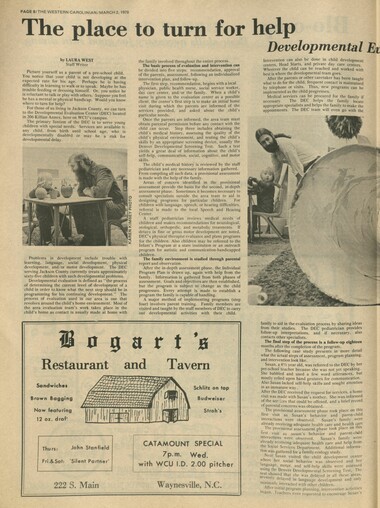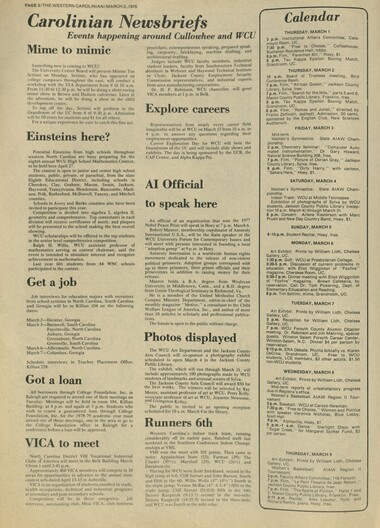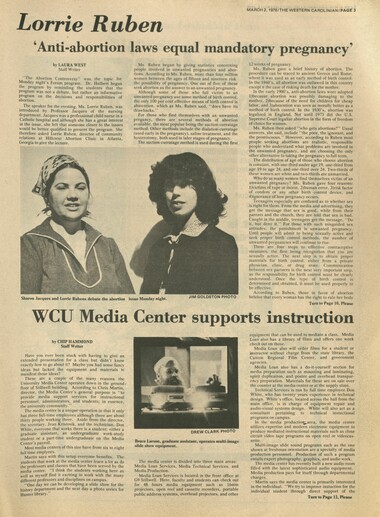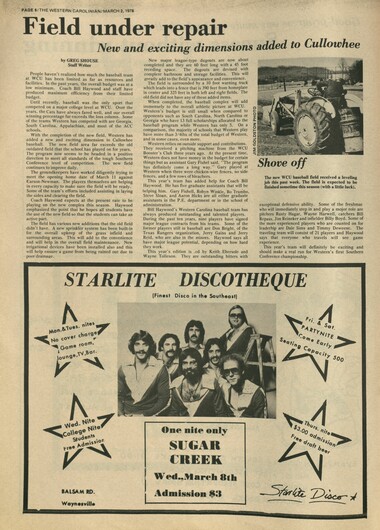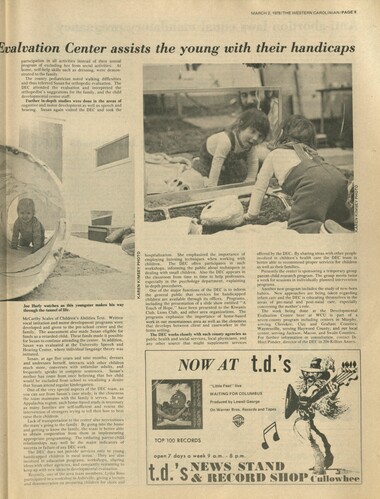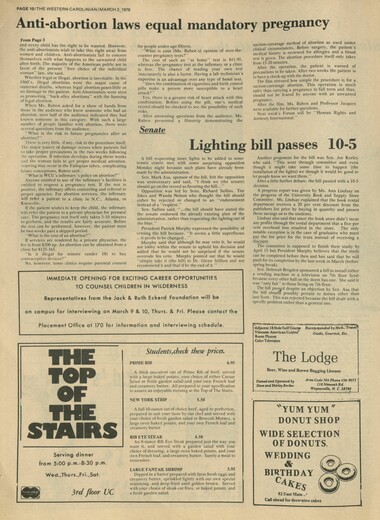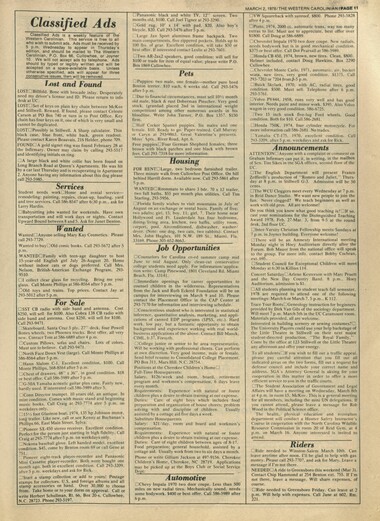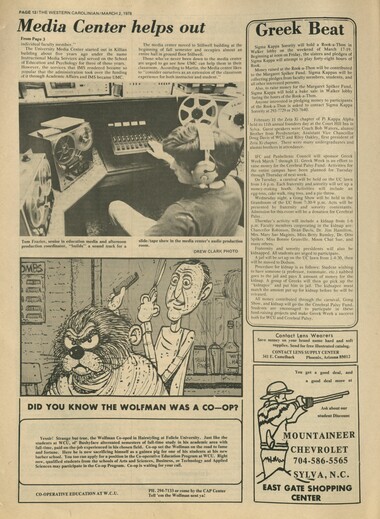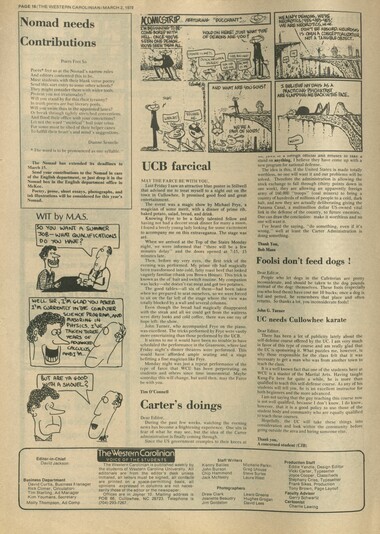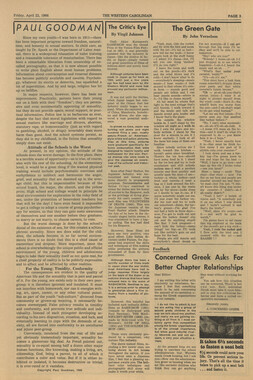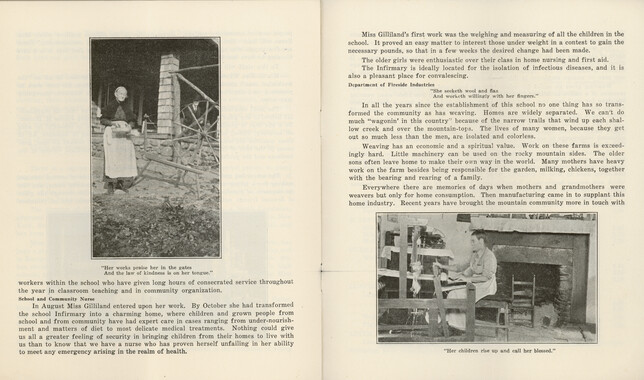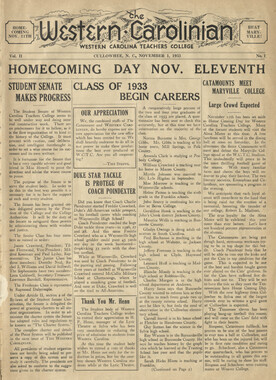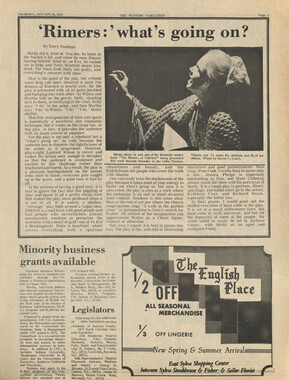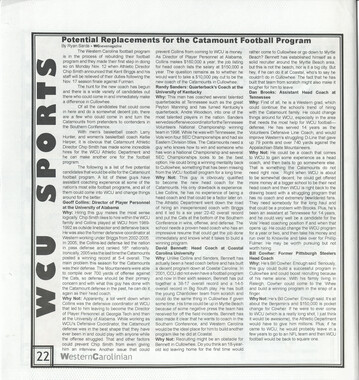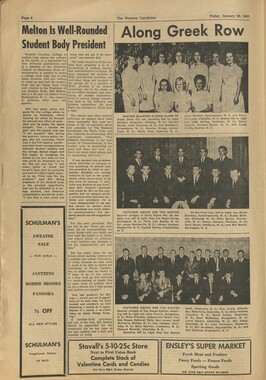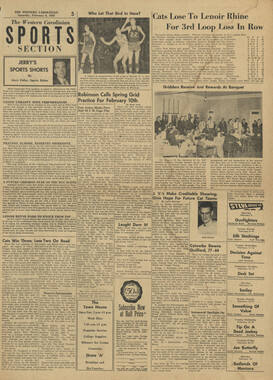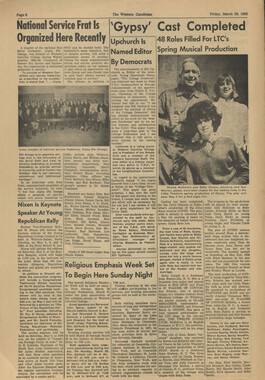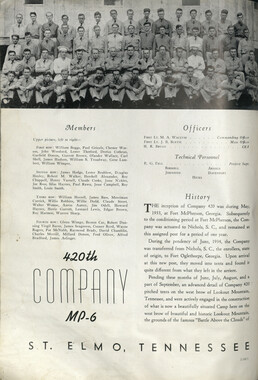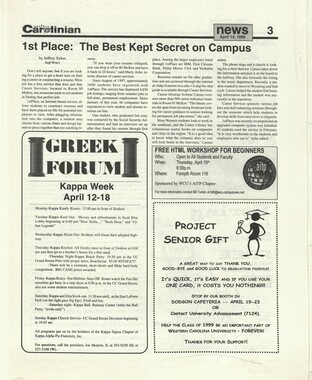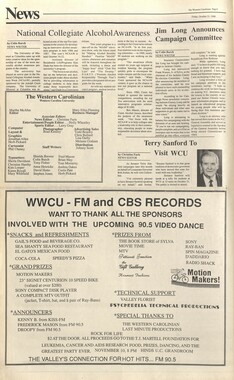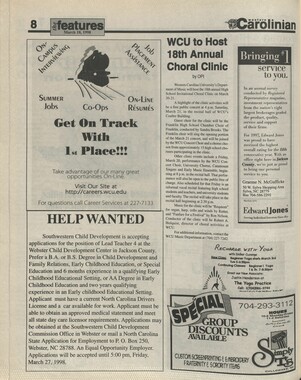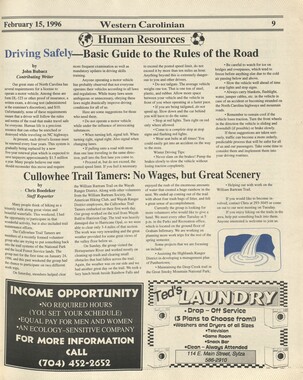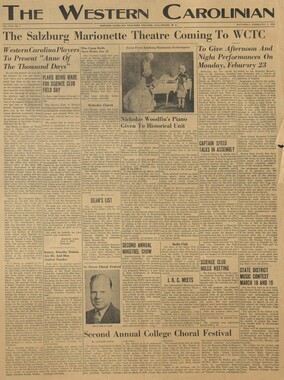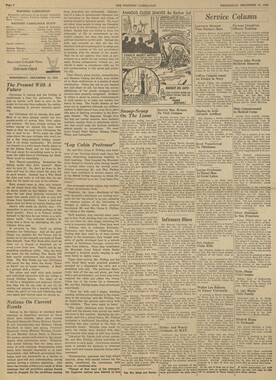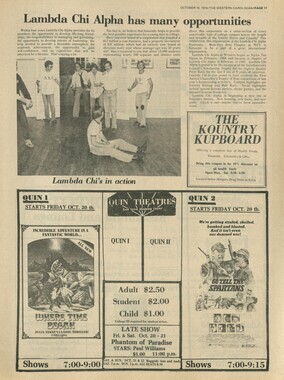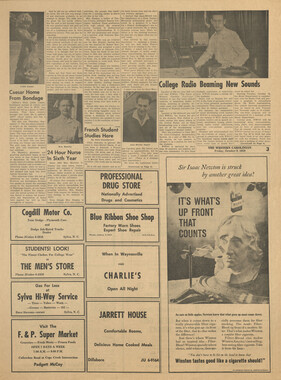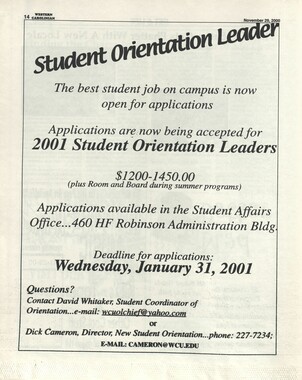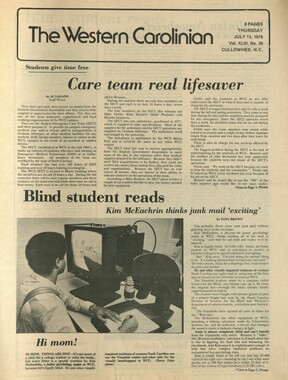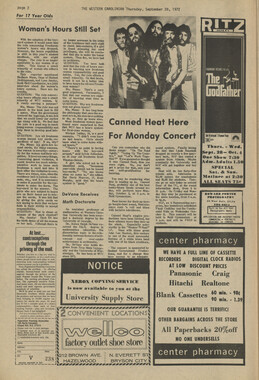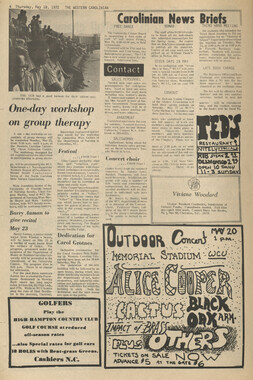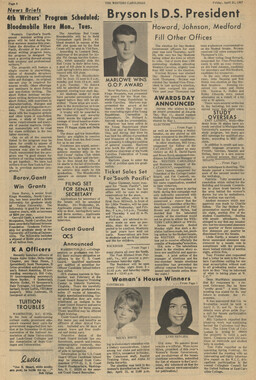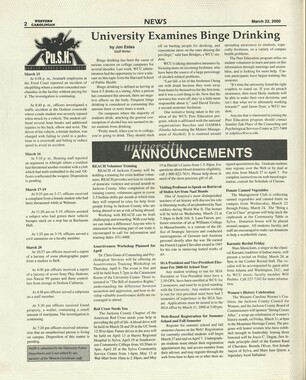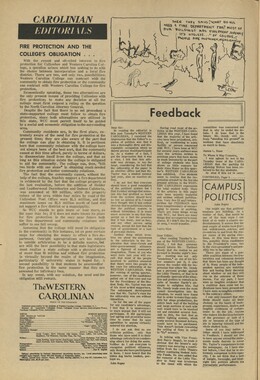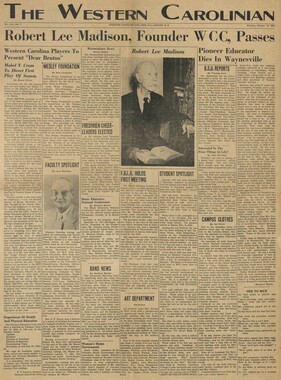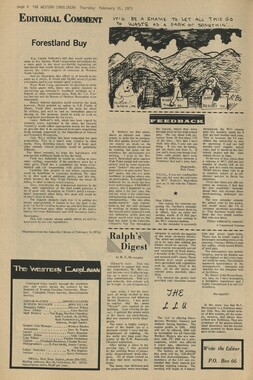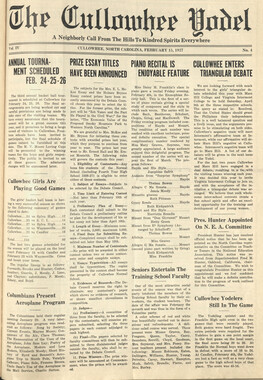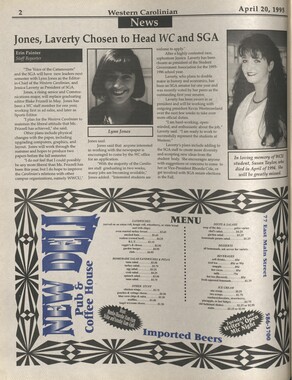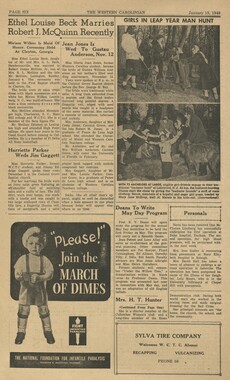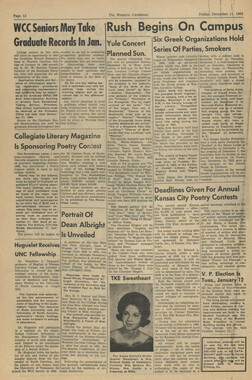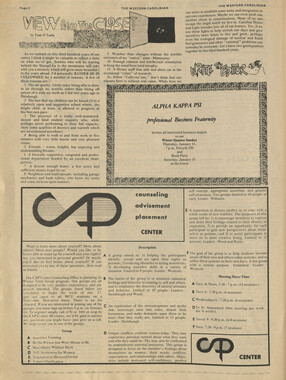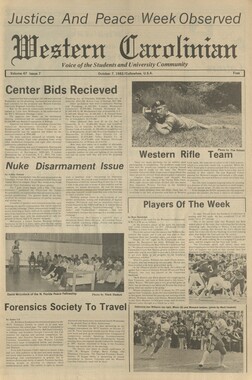Western Carolina University (20)
View all
- Canton Champion Fibre Company (2308)
- Cherokee Traditions (291)
- Civil War in Southern Appalachia (165)
- Craft Revival (1942)
- Great Smoky Mountains - A Park for America (2946)
- Highlights from Western Carolina University (430)
- Horace Kephart (941)
- Journeys Through Jackson (159)
- LGBTQIA+ Archive of Jackson County (85)
- Oral Histories of Western North Carolina (314)
- Picturing Appalachia (6798)
- Stories of Mountain Folk (413)
- Travel Western North Carolina (160)
- Western Carolina University Fine Art Museum Vitreograph Collection (129)
- Western Carolina University Herbarium (92)
- Western Carolina University: Making Memories (708)
- Western Carolina University Publications (2412)
- Western Carolina University Restricted Electronic Theses and Dissertations (146)
- Western North Carolina Regional Maps (71)
- World War II in Southern Appalachia (131)
University of North Carolina Asheville (6)
View all
- Allanstand Cottage Industries (62)
- Appalachian National Park Association (53)
- Bennett, Kelly, 1890-1974 (1388)
- Berry, Walter (76)
- Brasstown Carvers (40)
- Carver, George Washington, 1864?-1943 (26)
- Cathey, Joseph, 1803-1874 (1)
- Champion Fibre Company (233)
- Champion Paper and Fibre Company (297)
- Cherokee Indian Fair Association (16)
- Cherokee Language Program (22)
- Crowe, Amanda (40)
- Edmonston, Thomas Benton, 1842-1907 (7)
- Ensley, A. L. (Abraham Lincoln), 1865-1948 (275)
- Fromer, Irving Rhodes, 1913-1994 (70)
- George Butz (BFS 1907) (46)
- Goodrich, Frances Louisa (120)
- Grant, George Alexander, 1891-1964 (96)
- Heard, Marian Gladys (60)
- Kephart, Calvin, 1883-1969 (15)
- Kephart, Horace, 1862-1931 (313)
- Kephart, Laura, 1862-1954 (39)
- Laney, Gideon Thomas, 1889-1976 (439)
- Masa, George, 1881-1933 (61)
- McElhinney, William Julian, 1896-1953 (44)
- Niggli, Josephina, 1910-1983 (10)
- North Carolina Park Commission (105)
- Osborne, Kezia Stradley (9)
- Owens, Samuel Robert, 1918-1995 (11)
- Penland Weavers and Potters (36)
- Roberts, Vivienne (15)
- Roth, Albert, 1890-1974 (142)
- Schenck, Carl Alwin, 1868-1955 (1)
- Sherrill's Photography Studio (2565)
- Southern Highland Handicraft Guild (127)
- Southern Highlanders, Inc. (71)
- Stalcup, Jesse Bryson (46)
- Stearns, I. K. (213)
- Thompson, James Edward, 1880-1976 (226)
- United States. Indian Arts and Crafts Board (130)
- USFS (683)
- Vance, Zebulon Baird, 1830-1894 (1)
- Weaver, Zebulon, 1872-1948 (58)
- Western Carolina College (230)
- Western Carolina Teachers College (282)
- Western Carolina University (1899)
- Western Carolina University. Mountain Heritage Center (18)
- Whitman, Walt, 1819-1892 (10)
- Wilburn, Hiram Coleman, 1880-1967 (73)
- Williams, Isadora (3)
- Cain, Doreyl Ammons (0)
- Crittenden, Lorraine (0)
- Rhodes, Judy (0)
- Smith, Edward Clark (0)
- Appalachian Region, Southern (2569)
- Asheville (N.C.) (1923)
- Avery County (N.C.) (26)
- Blount County (Tenn.) (195)
- Buncombe County (N.C.) (1672)
- Cherokee County (N.C.) (283)
- Clay County (N.C.) (555)
- Graham County (N.C.) (233)
- Great Smoky Mountains National Park (N.C. and Tenn.) (519)
- Haywood County (N.C.) (3569)
- Henderson County (N.C.) (70)
- Jackson County (N.C.) (4804)
- Knox County (Tenn.) (35)
- Knoxville (Tenn.) (13)
- Lake Santeetlah (N.C.) (10)
- Macon County (N.C.) (420)
- Madison County (N.C.) (215)
- McDowell County (N.C.) (39)
- Mitchell County (N.C.) (132)
- Polk County (N.C.) (35)
- Qualla Boundary (981)
- Rutherford County (N.C.) (76)
- Swain County (N.C.) (2135)
- Transylvania County (N.C.) (270)
- Watauga County (N.C.) (12)
- Waynesville (N.C.) (86)
- Yancey County (N.C.) (72)
- Aerial Photographs (3)
- Aerial Views (60)
- Albums (books) (4)
- Articles (1)
- Artifacts (object Genre) (228)
- Bibliographies (1)
- Biography (general Genre) (2)
- Cards (information Artifacts) (38)
- Clippings (information Artifacts) (191)
- Copybooks (instructional Materials) (3)
- Crafts (art Genres) (622)
- Depictions (visual Works) (21)
- Design Drawings (1)
- Drawings (visual Works) (185)
- Envelopes (73)
- Exhibitions (events) (1)
- Facsimiles (reproductions) (1)
- Fiction (general Genre) (4)
- Financial Records (12)
- Fliers (printed Matter) (67)
- Glass Plate Negatives (381)
- Guidebooks (2)
- Internegatives (10)
- Interviews (815)
- Land Surveys (102)
- Letters (correspondence) (1013)
- Manuscripts (documents) (618)
- Maps (documents) (177)
- Memorandums (25)
- Minutes (administrative Records) (59)
- Negatives (photographs) (6015)
- Newsletters (1290)
- Newspapers (2)
- Notebooks (8)
- Occupation Currency (1)
- Paintings (visual Works) (1)
- Pen And Ink Drawings (1)
- Periodicals (193)
- Personal Narratives (10)
- Photographs (12976)
- Plans (maps) (1)
- Poetry (5)
- Portraits (4539)
- Postcards (329)
- Programs (documents) (151)
- Publications (documents) (2364)
- Questionnaires (65)
- Relief Prints (26)
- Sayings (literary Genre) (1)
- Scrapbooks (282)
- Sheet Music (2)
- Slides (photographs) (402)
- Songs (musical Compositions) (2)
- Sound Recordings (796)
- Specimens (92)
- Speeches (documents) (15)
- Tintypes (photographs) (8)
- Transcripts (322)
- Video Recordings (physical Artifacts) (23)
- Text Messages (0)
- A.L. Ensley Collection (275)
- Appalachian Industrial School Records (7)
- Appalachian National Park Association Records (336)
- Axley-Meroney Collection (2)
- Bayard Wootten Photograph Collection (20)
- Bethel Rural Community Organization Collection (7)
- Blumer Collection (5)
- C.W. Slagle Collection (20)
- Canton Area Historical Museum (2110)
- Carlos C. Campbell Collection (462)
- Cataloochee History Project (64)
- Cherokee Studies Collection (4)
- Daisy Dame Photograph Album (5)
- Daniel Boone VI Collection (1)
- Doris Ulmann Photograph Collection (112)
- Elizabeth H. Lasley Collection (1)
- Elizabeth Woolworth Szold Fleharty Collection (4)
- Frank Fry Collection (95)
- George Masa Collection (173)
- Gideon Laney Collection (452)
- Hazel Scarborough Collection (2)
- Hiram C. Wilburn Papers (28)
- Historic Photographs Collection (236)
- Horace Kephart Collection (861)
- Humbard Collection (33)
- Hunter and Weaver Families Collection (1)
- I. D. Blumenthal Collection (4)
- Isadora Williams Collection (4)
- Jesse Bryson Stalcup Collection (47)
- Jim Thompson Collection (224)
- John B. Battle Collection (7)
- John C. Campbell Folk School Records (80)
- John Parris Collection (6)
- Judaculla Rock project (2)
- Kelly Bennett Collection (1407)
- Love Family Papers (11)
- Major Wiley Parris Civil War Letters (3)
- Map Collection (12)
- McFee-Misemer Civil War Letters (34)
- Mountain Heritage Center Collection (4)
- Norburn - Robertson - Thomson Families Collection (44)
- Pauline Hood Collection (7)
- Pre-Guild Collection (2)
- Qualla Arts and Crafts Mutual Collection (12)
- R.A. Romanes Collection (681)
- Rosser H. Taylor Collection (1)
- Samuel Robert Owens Collection (94)
- Sara Madison Collection (144)
- Sherrill Studio Photo Collection (2558)
- Smoky Mountains Hiking Club Collection (616)
- Stories of Mountain Folk - Radio Programs (374)
- The Reporter, Western Carolina University (510)
- Venoy and Elizabeth Reed Collection (16)
- WCU Gender and Sexuality Oral History Project (32)
- WCU Mountain Heritage Center Oral Histories (25)
- WCU Oral History Collection - Mountain People, Mountain Lives (71)
- WCU Students Newspapers Collection (1843)
- Western North Carolina Tomorrow Black Oral History Project (69)
- William Williams Stringfield Collection (2)
- Zebulon Weaver Collection (109)
- African Americans (390)
- Appalachian Trail (35)
- Artisans (521)
- Cherokee art (84)
- Cherokee artists -- North Carolina (10)
- Cherokee language (21)
- Cherokee pottery (101)
- Cherokee women (208)
- Church buildings (172)
- Civilian Conservation Corps (U.S.) (111)
- College student newspapers and periodicals (1933)
- Dams (107)
- Dance (1023)
- Education (222)
- Floods (61)
- Folk music (1015)
- Forced removal, 1813-1903 (2)
- Forest conservation (220)
- Forests and forestry (1184)
- Gender nonconformity (4)
- Great Smoky Mountains National Park (N.C. and Tenn.) (181)
- Hunting (45)
- Landscape photography (25)
- Logging (119)
- Maps (83)
- Mines and mineral resources (8)
- North Carolina -- Maps (18)
- Paper industry (38)
- Postcards (255)
- Pottery (135)
- Railroad trains (72)
- Rural electrification -- North Carolina, Western (3)
- School integration -- Southern States (2)
- Segregation -- North Carolina, Western (5)
- Slavery (5)
- Sports (452)
- Storytelling (243)
- Waterfalls -- Great Smoky Mountains (N.C. and Tenn.) (66)
- Weaving -- Appalachian Region, Southern (280)
- Wood-carving -- Appalachian Region, Southern (328)
- World War, 1939-1945 (173)
Western Carolinian Volume 43 Number 23
Item
Item’s are ‘child’ level descriptions to ‘parent’ objects, (e.g. one page of a whole book).
-
-
PAGE 8/THE WESTERN CAROLINIAN/MARCH 2, 1978 The place to turn for help Developmental Et by LAURA WEST Staff Writer Picture yourself as a parent of a pre-school child. You notice that your child is not developing at the expected rate for his age. Perhaps he is having difficulty in learning to walk or to speak. Maybe he has trouble feeding or dressing himself. Or. you notice he is reluctant to talk or play with others. Suppose you feel he has a mental or physical handicap. Would you know where to turn for help? For those of us living in Jackson County, we can turn to the Developmental Evaluation Center (DEC) located in 206 Killian Annex, here on WCU's campus. The primary funtion of the DEC is to serve young children yvith special needs. Services are available tc any child, from birth until school age, who is developmentally disabled or may be a risk for developmental delay. Problems in development include trouble with learning, language, social development, physical development, and/or motor development. The DEC serving Jackson County currently treats approximately sixty-Five children with such developmental problems. Developmental evaluation is defined as "the process of determining the current level of development of a child in order to know what the next step should be in programming for his continuing development." The process of evaluation used in our area is one that revolves around the child's home environment. Most of the area evaluation team's work takes place in the child's home as contact is usually made at home with the family involved throughout the entire process. The basic process of evaluation and intervention can be divided into five steps: recommendation, approval of the parents, assessment, following an individualized intervention plan, and follow-up. The first step, recommendation, begins with a local physician, public health nurse, social service worker, day care center, and/or the family. When a child's name is given to the evaluation center as a possible client, the center's first step is to make an initial home visit during which the parents are informed of the services provided, and asked about the child's particular needs. Once the parents are informed, the area team must obtain parental permission before any contact with the child can occur. Step three includes obtaining the child's medical history, assessing the quality of the child's physical environment, and testing the child's skills by an appropriate screening device, usually the Denver Developmental Screening Test. Such a test yields a great deal of information about the child's self-help, communication, social, cognitive, and motor skills. The child's medical history is reviewed by the staff pediatrician and any necessary information gathered. From compiling all such data, a provisional assessment is made with the help of the family. Areas of concern identified in the provisional assessment provide the basis for the second, in-depth assessment phase. Sometimes it becomes necessary to consult specialists outside the area team to aid in designing programs for particular children. For children with language, speech, or hearing difficulties, referral is made to the local Speech and Hearing Center. A staff pediatrician reviews medical needs of children and makes recommendations for neurological. otological, orthopedic, and metabolic treatments. If delays in fine or gross motor development are noted, DEC's physical therapist evaluates and plans programs for the children. Also children may be referred to the Infant's Program at a state institution or an outreach program for autistic and communication-handicapped children. The family environment is studied through parental report and observation. After the in-depth assessment phase, the Individual Program Plan is drawn up, again with help from the family. Information is gathered from both phases of assessment. Goals and objectives are then established, but the program is subject to change as the child progresses. Every attempt is made to establish a program the family is capable of handling. A major method of implementing programs (step four) involves parent training. Family members are visited and taught by the staff members of DEC to carry out developmental activities with their child. S 0 9 a r 1 0 Restaurant and Tavern Sandwiches Brown Bagging Now featuring 12 oz. draf Schlitz on tap Budweiser Stroh's Thurs: John Stan field Fri.&Sat: 'Silent Partner' CATAMOUNT SPECIAL 7p.m. Wed. with WCU I.D. 2.00 pitcher L 222 S. Main Waynesville, N.C. Intervention can also be done in child development centers, Head Starts, and private day care centers. Wherever the child can be reached and worked with best is where the developmental team goes. After the parents or other caretaker has been taught what to do for the child, frequent contact is maintained by telephone or visits. Thus, new programs can be implemented as the child progresses. Medical services can be procured for the family if necessary. The DEC helps the family locate appropriate specialists and helps the family to make the appointments. The DEC team will even go with the family to aid in the evaluation process by sharing ideas from their studies. The DEC pediatrician provides follow-up interpretations, and if necessary, also contacts other specialists. The final step of the process Is a follow-up eighteen months after the completion of the program. The following case study presents in more detail what the actual steps of assessment, program planning, and intervention look like. Susan, a 4'/2 year old, was referred to the DEC by her pre-school teacher because she was not yet speaking. She babbled and used a few word utterances, but mostly relied upon hand gestures for communication. Also Susan lacked self-help skills- and sought attention in an immature way. After the DEC received the request for services, a home visit was made with Susan's mother. She was informed of the services that could be offered, and a brief record of parental concerns was obtained. The provisional assessment phase took place on this first visit as Susan's behavior and paren-chiid interactions were observed. Susan's family were already receiving adequate health care and health care The provisional assessment phase took place on this first visit as jusan's behavior and parent-child interactions were observed. Susan's family were already receiving adequate health care and help from the Social Services Department. Additional information was gathered for a family ecology study. Next Susan visited the child development center where her social behavior was observed and her language, motor, and self-help skills were assessed using the Denver Developmental Screening Test. The seens , ?d that she was delayed in all these areas. •v delayed in language development and only minimally interacted with other children. After initial program planning, intervention activities began. Teachers were requested to encourage Susan's
Object
Object’s are ‘parent’ level descriptions to ‘children’ items, (e.g. a book with pages).
-
The Western Carolinian is Western Carolina University’s student-run newspaper. The paper was published as the Cullowhee Yodel from 1924 to 1931 before changing its name to The Western Carolinian in 1933.
-
